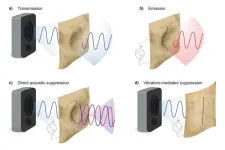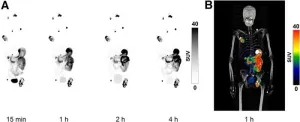(Press-News.org) DETROIT — Fu-Shin Yu, Ph.D., professor of ophthalmology, visual and anatomical sciences in the Wayne State University School of Medicine, received an award from the National Eye Institute of the National Institutes of Health for his study aiming to reverse the adverse effects of diabetes on eyesight.
The five-year grant for $2,167,882 will benefit Yu’s research “Role of Programmed Cell Death Pathways in Bacterial Keratitis,” Which will investigate biological processes that contribute to defects in immune response in the eyes of those with diabetes and identify methods to reverse them.
“The cornea, located at the front of the eye, is our focus,” said Yu. “We aim to understand why diabetic patients are more suspectable to keratitis, or corneal infection. Why does the disease progress faster in these patients, and why are they more resistant to treatments? Diabetic patients are about 30% more likely to experience corneal infections.”
Yu's research group uses mouse models of both type 1 and type 2 diabetes, along with Pseudomonas aeruginosa as a model pathogen. In May 2023, the Centers for Disease Control and Prevention (CDC) confirmed 81 cases of a drug-resistant Pseudomonas aeruginosa strain across 18 states, resulting in four deaths, 14 cases of vision loss and four cases of enucleation. This underscores the urgent need to better understand the mechanisms underlying the increased susceptibility and severity of bacterial keratitis in diabetic patients.
Diabetic patients can have a higher incidence of infection, with higher disease severity and an increased resistance to some treatments, resulting in increased susceptibility to the rapid progression of microbial keratitis in the corneas of those affected by diabetes.
“We found evidence that mice are more susceptible to corneal infections,” said Yu. “Our approach involves analyzing samples from the mice’s infected corneas with similar severity. We look at the RNA sequences in the samples and compare the progression of the infection and identify the pathways, or biological processes. By comparing normal pathways to diabetic pathways, we can explore potential treatment avenues.”
The CDC reported that in 2018, approximately 34.2 million people in the United States — roughly 10.5% of the nation’s population — had diabetes.
“The loss of sight can be debilitating, and diabetes, which contributes to sight loss, is a condition that affects countless individuals,” said Ezemenari M Obasi, Ph.D., vice president for research at Wayne State University. “Dr. Yu and other Wayne State researchers are addressing many issues that may have a significant impact on people’s lives now and in the future. It is an excellent example of how Wayne State University is playing a unique and influential role in Detroit and beyond by advancing the health and well-being of our communities.”
The grant number for this National Eye Institute of the National Institutes of Health award is R01EY035785.
# # #
Wayne State University is one of the nation's pre-eminent public research institutions in an urban setting. Through its multidisciplinary approach to research and education, and its ongoing collaboration with government, industry and other institutions, the university seeks to enhance economic growth and improve the quality of life in the city of Detroit, the state of Michigan and throughout the world. For more information about research at Wayne State University, visit research.wayne.edu.
END
Firefighters may have an increased risk of prostate cancer due to on-the-job chemical exposures, according to new research from the University of Arizona Mel and Enid Zuckerman College of Public Health and University of Michigan in collaboration with fire service partners and researchers around the country through the Fire Fighter Cancer Cohort Study.
Prostate cancer is the leading incident cancer among U.S. males. Firefighters are diagnosed with prostate cancer at a rate 1.21 times higher than the general population, possibly because of chemical exposures including smoke and firefighting foam during firefighting.
Some of those chemicals ...
A collection of seven technologies for lithium recovery developed by scientists from the Department of Energy’s Oak Ridge National Laboratory has been licensed to Element3, a Texas-based company focused on extracting lithium from wastewater produced by oil and gas production.
The technologies were developed through the Critical Materials Innovation Hub, a DOE Energy Innovation Hub led by Ames National Laboratory that is dedicated to accelerating scientific and technological solutions to ensure secure domestic supply chains for ...
At a glance:
How well a newly minted doctor scores on their medical board exam appears linked to patients’ odds of dying or being readmitted to the hospital.
Doctors’ performance on ratings of knowledge and skill taken periodically during residency training is not linked to patient outcomes.
Findings offer reassurance that certification exams, which aim to demonstrate the competence of physicians, capture critical knowledge and clinical judgment skills for physicians.
How do we know whether newly minted doctors have what it takes to ...
“[...] this study is an initial examination of the associations between epigenetic and transcriptomic aging biomarkers and novel NMR lipoprotein biomarkers.”
BUFFALO, NY- May 7, 2024 – A new research paper was published in Aging (listed by MEDLINE/PubMed as "Aging (Albany NY)" and "Aging-US" by Web of Science) Volume 16, Issue 8, entitled, “Associations among NMR-measured inflammatory and metabolic biomarkers and accelerated aging in cardiac catheterization patients.”
Research ...
We are living in a very noisy world. From the hum of traffic outside your window to the next-door neighbor’s blaring TV to sounds from a co-worker’s cubicle, unwanted noise remains a resounding problem.
To cut through the din, an interdisciplinary collaboration of researchers from MIT and elsewhere developed a sound-suppressing silk fabric that could be used to create quiet spaces.
The fabric, which is barely thicker than a human hair, contains a special fiber that vibrates when a voltage is applied to it. The researchers leveraged those vibrations to suppress ...
NEW YORK, May 7, 2024 — A team of researchers from the CUNY Graduate Center, the CUNY Advanced Science Research Center (CUNY ASRC), Brooklyn College, and Lehman College has been selected to receive a highly competitive cooperative agreement award aimed at expanding and innovating NASA’s Global Learning and Observations to Benefit the Environment (GLOBE) program. The five-year, $11.1-million project awarded to the CUNY Graduate Center will help advance GLOBE’s mission to create a worldwide community of students, educators, scientists, and members of the public who work together to better understand, ...
Reston, VA—A novel investigational PET imaging agent can rapidly and accurately visualize lesions in clear cell renal cell cancer (ccRCC) patients according to new research published in the May issue of The Journal of Nuclear Medicine. The results of the study suggest that the agent 68Ga-DPI-4452 (Debio 0328) is superior to standard CT imaging in the context of ccRCC. It also allows for significantly faster imaging and, in the future, could be utilized as part of a theranostic pair.
ccRCC accounts for 70-80 percent of renal cell carcinoma ...
UCLA Health is set to host a unique symposium this week to explore the evolving research in psychedelic therapies and how combining it with reconnection to natural world could help to amplify their mental health benefits.
The all-day symposium on May 10 at the UCLA campus will bring together the expertise and insights of researchers from UCLA Health’s Psychedelic Studies Initiative and the Jane and Terry Semel Institute for Neuroscience and Human Behaviors as well as filmmakers, psychiatrists, urban planners, indigenous health experts, writers and environmental leaders from throughout the world.
“Promising ...
In a fast-paced digital age where patients can open their test results as soon as they are available, what happens when a patient reads through complicated results without a physician there to help them understand what it all means? And what happens when a patient misinterprets bad news as good news, or vice versa?
It’s a scenario Benjamin Vipler, MD, confronted after his mom received her colonoscopy results on her health system’s patient portal. Like many patients, she opened up her results before meeting with her clinician and tried to decipher the medical jargon. Thinking the results showed she ...
As people have more difficulty distinguishing fact from fiction in the United States, they are more likely to feel news fatigue and avoid news altogether, according to a University of Michigan study.
More than an unintentional avoidance because of lack of media exposure, the researchers say people actively avoid news.
The researchers also find that people who identify as strong Democrats begin relying more on nonpartisan news media when feeling misinformed, while people who identify as strong Republicans report using less news media overall, including less conservative news media. Their results are published in Journalism Studies.
"The more confusing ...




